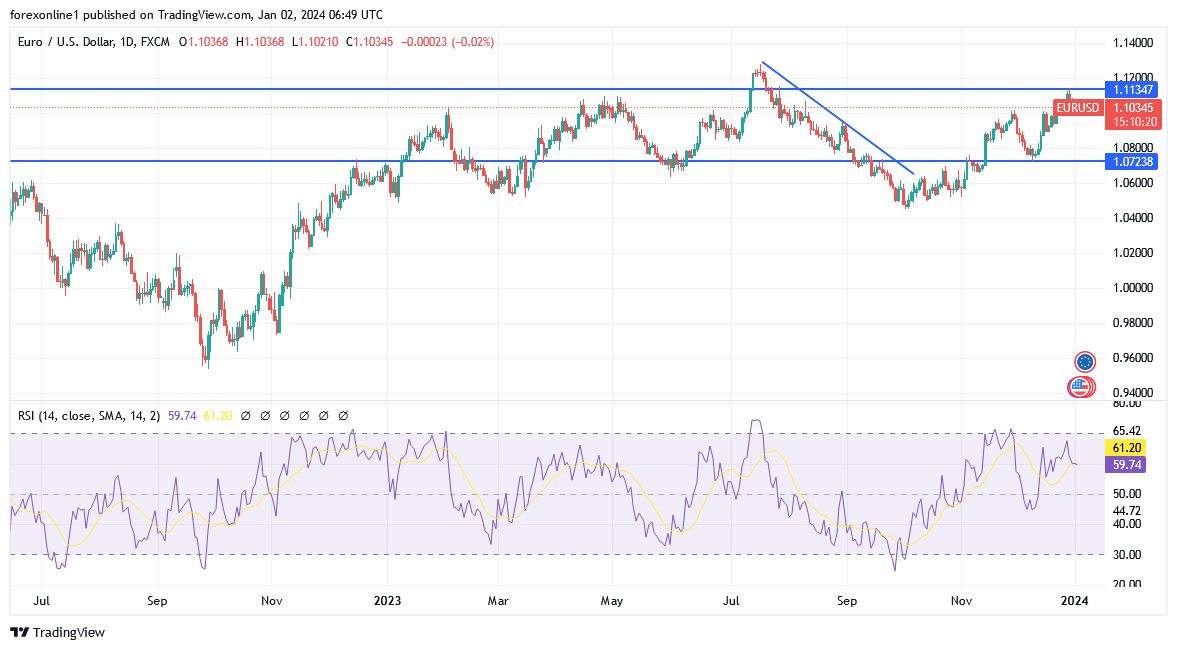Relative stability is seen in the early trading of 2024, and the EUR/USD pair is likely to receive signals from the primary catalysts in the United States during this week. Recently, the euro-dollar is stabilizing around the 1.1040 level, down from the resistance level of 1.1140 that the pair moved to in the shortened trading week for the holidays. Meanwhile, the minutes of the Federal Open Market Committee (FOMC) meeting are scheduled to be released in the middle of this week and may contain evidence on whether the US central bank is likely to cut interest rates in the near future.

Remember that the dot plot of expectations hinted at three cuts in US interest rates this year, and Fed Chair Jerome Powell had indicated that more discussions on the timing of easing could be seen in the FOMC meeting minutes. In general, cautious statements from policymakers could translate into dollar declines and increased risk appetite, which could mean an upward trend for the currency pair. On the other hand, the possibility of the Fed staying on hold due to strong job data and wage inflation could mean a rise in the dollar, leading to selling of the euro against the US dollar.
On the future of the euro, European Central Bank (ECB) President Christine Lagarde said in an opening article to mark the upcoming 25th anniversary of the currency that the euro helps Europe to stay in charge of its destiny on the global stage. Recently, Lagarde wrote in the article co-written with Ursula von der Leyen, Charles Michel, Roberta Metsola, and Paschal Donohoe, the presidents of the European Commission, the Council, the European Parliament, and the European Council, that “the issuance of the world's second most important currency has given us greater sovereignty in a turbulent world.”
The officials added, “We are facing increasing geopolitical tensions, not least Russia’s illegal war against Ukraine, which requires bold collective decisions,”. Added, “We are facing an accelerating climate crisis that we can only solve together: carbon emissions do not stop at borders.” Ended by said that we face unprecedented challenges to our competitiveness from energy and industry policies in other parts of the world.
Historically, the euro zone union was launched by 11 countries at the beginning of 1999, and the euro remained an electronic currency for the first three years. Now, the eurozone includes 20 countries, making it the means of payment for about 350 million people. Therefore, “This has made life easier for European citizens, who can easily compare prices, trade and travel,” the leaders added, “It has given us stability, protecting growth and jobs amid a series of crises.”
Recently, the euro reached the quarter-century mark on January 1 shows the resilience of a monetary arrangement whose disintegration was often expected. As the Greek crisis raged in 2015, for example, former Federal Reserve Chairman Alan Greenspan opined that “it is only a matter of time before everyone realizes that parting ways is the best strategy.” Greece did not leave, and instead, the region welcomed its newest member, Croatia, at the beginning of 2023.
Two other Euro hopefuls were not so lucky. Romania's efforts to gain membership have been hampered by internal squabbles, which is evident in the highest rates of change of governments in the European Union. Bulgaria, the poorest country in the bloc, was forced this year to abandon its plan to join in 2024.
Meanwhile, adopting the euro is in theory a condition for joining the EU, the Czech Republic, Hungary, Poland, and Sweden do not appear interested. Denmark, which chose not to join before the dawn of the currency, did not budge either. For the euro, the story is similar. Due to weak calendar data, the cryptocurrency may continue to struggle to find firm support during Friday's session. However, if the ECB continues its tough stance against imminent interest rate cuts and proves convincing to investors, the euro could rise.
Top Forex Brokers
Technical analysis of the EUR/USD pair:
Technically, the price of the EUR/USD formed higher lows connected to the ascending trend line visible on the 4-hour time frame chart. Also, the price appears ready for another decline to support near Fibonacci retracement levels. Recently, the 38.2% Fibonacci level is located at 1.0982 while the 50% level is located near the dynamic support of the 100 SMA at 1.0934, in addition to the previous area of interest or resistance.
The largest correction may reach the 61.8% level near the trend line at 1.0886. moreover, the 100-SMA is trying to stay above the 200 SMA to confirm that the trend has a chance to go up or that the rally is likely to gain strength. However, the Stochastic indicator is heading downwards to show that downward pressure exists, and that the correction may continue until oversold levels are achieved. Furthermore, the RSI has room to fall before it reverses oversold levels, so the price can continue to follow the same path while there is bearish momentum. In general, a break below the support level may lead to a reversal of the upward trend.
Ready to trade our Forex daily forecast? We’ve shortlisted the best FX trading platform in the industry for you
